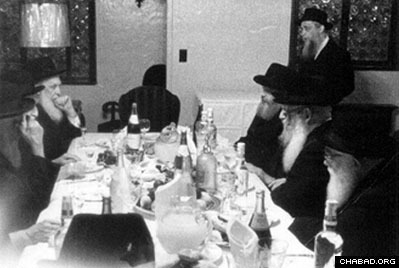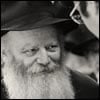"In 1963, I won a raffle to travel from Israel to New York to spend the High Holidays with the Rebbe in 770 [address of and shorthand for Lubavitch World Headquarters]," says Rabbi Yekutiel Green. Thus, as the representative of the Israeli community, Rabbi Green was one of ten people invited to eat the holiday meal of Simchat Torah with the Rebbe.

The meal would take place in what had been the home of the Rebbe's father-in-law, the sixth Rebbe, Rabbi Yosef Yitzchak Schneersohn, of righteous memory. The apartment, on the second floor of Lubavitch World Headquarters, was kept the same way it had been while Rabbi Yosef Yitzchak was alive and, out of holy deference, the table, too, was set up with a place setting for the previous Rebbe (see Talmud Ketubot 103a).
The Rebbe and his older brother-in-law, Rabbi Shmaryahu Gurary, would also sit in the same places they did during their father-in-law's lifetime. During the meal, Rabbi Gurary would often ask the Rebbe scholarly questions, and the Rebbe would respond in a somewhat concise manner.
Many of the questions were suggested to Rabbi Gurary by Lubavitch scholars prior to the holiday. The questions were unique, about customs or intricate details of the holiday, and many of them had no natural place to be addressed other than at the holiday table. Sometimes the Rebbe would address the questions later, at large gatherings ("farbrengens") over the holiday.
(Two volumes of these conversations at the table have been published to date. Many of the conversations at that table were recorded only in the personal diaries of attendees and are still being discovered today.)
Only a small number of people could squeeze into the sixth Rebbe's apartment, and many of the guests were regulars (elderly chasidim who had no family or the like), so it was with great excitement that a yeshiva student would land the coveted job of waiter for a meal and thus be able to observe the proceedings. This honor would often be passed on from friend to friend. At the Rebbe's insistence, the yeshiva student, too, would join the meal.
"I sat at the end of the right side of the table," says Rabbi Green. He recalls sitting next to Rabbi Yehudah (Yudel) Shmotkin, an elderly Jew from Tel Aviv. "He was constantly reminding me to eat each course as quickly as possible."
This was because once the Rebbe stopped eating, everyone else would also put down their forks or spoons out of respect. But the Rebbe noticed this, and did not want anyone not to have a full portion of food. So, Rabbi Green explains, the Rebbe would eat very slowly so that everyone had time to finish eating.
Additionally, Green observes, "the Rebbe would not start eating until every last person had received their portion of food and the young waiter had sat down at the table to eat."
None of the guests, certainly not the waiter, would have been offended if the Rebbe had begun eating before them, nor would they have been bothered if they had not had their fill before the Rebbe finished eating. The food was secondary; it was a great honor to be present at the Rebbe's holiday meal and a delight to hear the Torah insights with which the Rebbe replied to the questions posed to him.
"These sensitive gestures by the Rebbe were very moving for me to observe," says Rabbi Green, "and, until today, I have implemented them at our meals at home."





